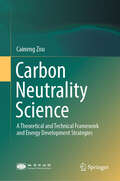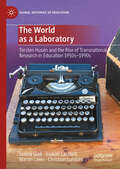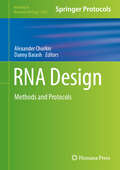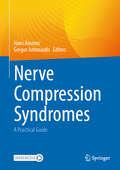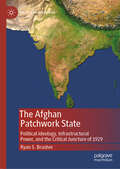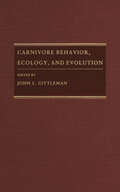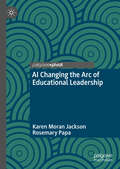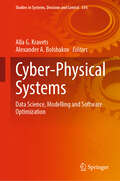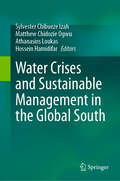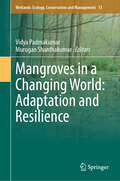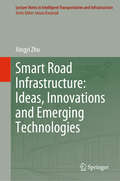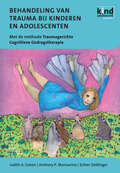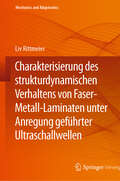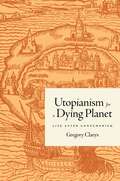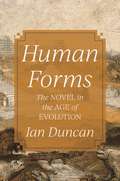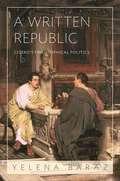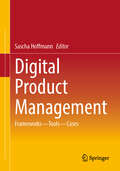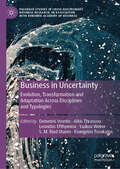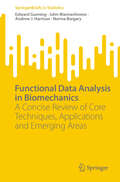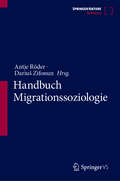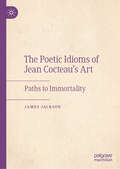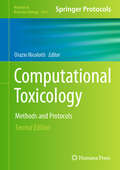- Table View
- List View
Carbon Neutrality Science: A Theoretical and Technical Framework and Energy Development Strategies
by Caineng ZouThis book focuses on the connotation and extension of carbon neutrality. It presents a full collection of various topics in carbon neutrality, including carbon production, reduction, utilization, storage, capture, markets, and society, etc. It concludes that carbon neutrality is the pathway to global green and low-carbon sustainable development and the foundation for building harmonious ecological civilization. This book is a valuable reference for researchers, practitioners, and policy-makers in the field of earth and environmental sciences.
Wetlands and Lakes of the World
by Devashish KarThe occurrence and description of wetlands in India with reference to those around the world is detailed in a sequential manner from local, provincial, regional, and national to global scenario in this book, “Wetlands and Lakes of the World”. The book also deals with a systematic, sequential and comprehensive treatment of the Limnology (physico-chemical and biological features) and Fisheries of the Wetlands in India and is well supported by author’s original data. As Limnology and Fishery Science are interlinked, this book attempts to provide a holistic view of both the fields, along with their methodologies. The book has numerous examples from the local environment that go along with the explained theoretical concepts. Furthermore, a unique feature of the book is that it deals with the protocols of various Limnological methodologies, thus, making it a handy guide for lab and field studies. The book has distinguished itself by incorporating chapter based on Global Information System or GIS. The book also has an up to date Bibliography and summary at the end of each chapter with text on various aspects, particularly, generally not much dealt with aspects like fisherfolk, their fish catching devices, fishing centers, fish markets and, above all, their socio-economic conditions supported by author’s original data. In Brief.. “Wetlands and Lakes of the World” is, a humble treatise to provide the undergraduates with a text concentrating on the common, fundamental features of all aquatic systems, and the for the postgraduates, researchers, policy makers, administrators, etc.with the details of processes and applications with examples.
A Short Guide to Clinical Pharmacokinetics
by Krishnaveni Manubolu Raveesha Peeriga K. B. ChandrasekharThis book is a complete resource on pharmacokinetics, pharmacodynamics and pharmacogenomics in clinical practice. It consists of seven chapters that cover various aspects of pharmacokinetics and its clinical applications. The chapters are structured to provide clear objectives and keywords are bolded throughout the text to facilitate understanding. The topics covered include the significance of pharmacokinetics in clinical practice, factors affecting pharmacokinetic parameters, pharmacokinetic drug interactions, therapeutic drug monitoring, dosage adjustment in different population groups, the influence of hepatic diseases on pharmacokinetics and the impact of pharmacogenomics on pharmacokinetics and pharmacodynamics. The book is written in simple language to make the concepts accessible to all readers. This book is a comprehensive resource for students pursuing a doctoral degree in pharmacy, as well as academicians and researchers in clinical pharmacokinetics.
The World as a Laboratory: Torsten Husén and the Rise of Transnational Research in Education 1950s–1990s (Global Histories of Education)
by Martin Lawn Sotiria Grek Joakim Landahl Christian LundahlThis book covers the construction of international education research community in the 1950s-1990s, and the growth of its ‘disembedded’ laboratory i.e. networks, spaces, materiality, travelling, translations. The book follows a sociology of science theoretical framework in order to examine the research-archive of the Swedish internationally renowned educational scholar Torsten Husén (1916-2009). The archive reveals the shifting and heterogenous transnational networks that contribute to the development of social science research beyond fixed time and space dimensions, and that extends social science beyond individual ideas, researchers, environments, institutions and universities. These are practices that create, mobilise, sustain and challenge relations between actors in innovations, knowledge creation and various social activities. In other words, the archive represents the socio-material manifestation not only of the intellectual trajectory of a key education actor but the growing organisation of a whole scientific field at the time.
RNA Design: Methods and Protocols (Methods in Molecular Biology #2847)
by Alexander Churkin Danny BarashThis volume provides comprehensive methods on RNA design. Chapters details traditional RNA design in secondary structure, RNA design in tertiary structure, and RNA design applications and assessments. Written in the highly successful Methods in Molecular Biology series format, chapters include introductions to their respective topics, lists of the necessary materials and reagents, step-by-step, readily reproducible laboratory protocols, and key tips on troubleshooting and avoiding known pitfalls. Authoritative and cutting-edge, RNA Design: Methods and Protocols aims to ensure successful results in the further study of this vital field.
Nerve Compression Syndromes: A Practical Guide
by Hans Assmus Gregor AntoniadisThe clinic, diagnosis and treatment of all common and rare nerve compression syndromes are also described in detail in the 4th edition of the book. Their treatment is an interdisciplinary task involving neurologists, neuroradiologists and surgeons from different specialties (hand surgeons, neurosurgeons, orthopaedic and trauma surgeons, plastic surgeons).Further chapters deal with the electrophysiological and imaging procedures for diagnosis. Special forms and the differentiation from focal neuropathies of other causes are also included.The surgical techniques are illustrated with numerous drawings and photographs. The SpringerNature MoreMedia app can also be used to access videos on sonographic examinations and surgical procedures.A book that leaves no question unanswered on the subject of nerve compression syndrome!
The Afghan Patchwork State: Political Ideology, Infrastructural Power, and the Critical Juncture of 1929 (Politics of South Asia)
by Ryan S. BrasherThis book provides a theoretically grounded and empirically fine-grained analysis of uneven state development in Afghanistan beginning in the early 20th Century. Based on archival research, the book shows that after Amanullah Shah’s abortive modernist authoritarian experiment and Habibullah Kalakani’s brief rule, a newly empowered Musahiban dynasty charted a patrimonial absolutist course. The new regime delegated considerable authority to traditional tribal areas in the southeastern and eastern part of the country, while pursuing a coercive strategy in other parts of the country that usurped traditional leadership at the regional and local levels. Previous explanations of the weakness of the Afghan state tend to emphasize structural determinants such as difficult geography, acephalous tribal organization, ethnic heterogeneity, as well as colonial interventions. Others have focused only on events after the Soviet or NATO interventions, pointing out faulty external decision-making, corrupt government officials and warlords, neighboring insurgent safe havens, or the international aid-fueled rentier economy. This book proposes an intermediate explanation for the patchwork nature of the Afghan state rooted in institutional choices made by a new ruling elite that took over in 1929. The year represents one critical juncture in Afghan history, where individual agency based on certain ideological preferences set in motion a path-dependent process that shaped its politics well into the latter half of the century.
Carnivore Behavior, Ecology, and Evolution
by John L. GittlemanCarnivores have always fascinated us, even though they make up only 10% of all mammalian genera and only about 2 % of all mammalian biomass. In Greek mythology most of the gods adorned their robes and helmets with depictions of carnivores, and the great hero Hercules' most famous feat was killing the "invulnerable" lion with his bare hands. Part of our fascination with carnivores stems from fright and intrigue, and sometimes even hatred because of our direct competition with them. Cases of "man-eating" lions, bears, and wolves, as well as carnivores' reputation as killers of livestock and game, provoke communities and govermllents to adopt sweeping policies to exterminate them. Even President Theodore Roosevelt, proclaimer of a new wildlife protectionism, described the wolf as "the beast of waste and desolation. " The sheer presence and power of carnivores is daunt ing: they can move quickly yet silently through forests, attaining rapid bursts of speed when necessary; their massive muscles are aligned to deliver powerful attacks, their large canines and strong jaws rip open carcasses, and their scis sor-like carnassials slice meat. Partly because of our fear of these attributes, trophy hunting of carnivores has been, and to a certain extent still is, a sign of bravery and skill. Among some Alaskan Inuit, for example, a man is not eligible for marriage until he has killed a succession of animals of increasing size and dangerousness, culminating with the most menacing, the polar bear.
AI Changing the Arc of Educational Leadership
by Rosemary Papa Karen Moran JacksonAs artificial intelligence becomes an all-encompassing issue in education and beyond, this book seeks to answer how it will change the arc of educational leadership in K-12 schooling. Educators and leaders serve as the champions and gatekeepers of technology use in schools. They need to consider how AI can change education for the better while keeping in mind cultural, social, and emotional concerns that cannot be isolated from educational settings. Jackson and Papa examine existing literature and include insightful interviews with professionals in AI and education to understand how educators currently perceive and use AI. They also illustrate the similarities and differences in how educators and A.I.ED developers envision AI's present and future.
Cyber-Physical Systems: Data Science, Modelling and Software Optimization (Studies in Systems, Decision and Control #554)
by Alla G. KravetsThis book is devoted to new approaches to modeling and design of cyber-physical systems. Nowadays, cyber-physical systems become widely used in different domains. Scientific society suggests new approaches to engineering and optimization of cyber-physical systems, however, there are still open questions that need to be covered by research and development. It presents results and findings in the field of Data Science and digital twin engineering for cyber-physical systems. This book provides scientific, practical, and methodological approaches to modeling of complex processes for cyber-physical systems. The authors highlight essential results on software optimization in cyber-physical systems. The target audience of the book are practitioners, enterprise representatives, scientists, Ph.D., and master’s students who perform scientific research or applications of cyber-physical systems for various domains.
Water Crises and Sustainable Management in the Global South
by Sylvester Chibueze Izah Matthew Chidozie Ogwu Hossein Hamidifar Athanasios LoukasThis book is a reference material on how to sustainably manage water crises. The causes and effects of water crises under different regions in the Global South are explored in this book. Approaches for the sustainable management of water crises are also highlighted in the book, especially in the Global South, where the level of technologies available for sustainable management of water are limited. Water crisis is a global problem but with disproportionate higher consequences in the lobal South. About 25% of the global population resides in water-stressed countries, and about 10% of the world population lives in areas with high water vulnerability. Furthermore, many millions of people across the globe lack access to potable water supplies. As such, many people could be displaced by water crises or scarcity shortly. The effects of the water crisis on the environment include increased salinity, nutrient pollution, the loss of floodplains, the drying ofriverbeds, the loss of habitat, wetlands disappearing, and ecosystem loss. On the human level, it could lead to disease outbreaks, drought, famine, and death. This may have more severe effects in countries in the Global South as compared to nations in the Global North. This is because the water cycle is very intense in Asia and Africa, which are important areas in the Global South. This book is of interest and useful to aquatic toxicologists, water quality experts, practitioners, trainees, and trainers, environmentalists, biological sciences scientists, academics, researchers, students (especially undergraduates and postgraduates), libraries, and other public knowledge repositories interested in novel and advanced practices in sustainable water management.
Mangroves in a Changing World: Adaptation and Resilience (Wetlands: Ecology, Conservation and Management #13)
by Vidya Padmakumar Murugan ShanthakumarMangroves are among the most productive and diverse ecosystems on Earth, providing a range of ecosystem services that benefit millions of people and support global sustainability goals. However, mangroves are also highly vulnerable to climate change impacts, such as sea level rise, storms, salinity changes, and erosion, which threaten their survival and functionality. This book aims to provide researchers with the latest scientific knowledge and practical tools to understand, assess, and enhance the adaptation and resilience of mangroves to climate change. It covers topics such as mangrove ecology and distribution, mangrove ecosystem services and valuation, mangrove adaptation and resilience mechanisms and indicators, mangrove restoration and conservation strategies, mangrove governance and policy frameworks, and mangrove modelling and mapping approaches. The book also showcases case studies from different regions of the world, highlighting the challenges and opportunities of mangrove management in a changing world. The book is intended to serve as a valuable reference and resource for researchers, students, practitioners, policymakers, and anyone interested in mangrove science and management.
Smart Road Infrastructure: Ideas, Innovations and Emerging Technologies (Lecture Notes in Intelligent Transportation and Infrastructure)
by Xingyi ZhuThis book focuses on the fundamental ideas in the future smart transportation infrastructure systems that, in turn, give rise to new architectures and applications of emerging technologies. Although the scope of transportation infrastructure systems is very broad, this book focuses in detail on the main one—urban road infrastructure systems. Based on the investigation of the development trend and current situation of the smart road infrastructure (SRI), this book clarifies the connotation, architecture, and implementation path of the SRI. Emerging technologies related to SRI have also been summarized, which is useful for SRI design and construction. The book is intended for undergraduate and graduate students who are interested in the SRI technology or intelligent transportation systems and road/transportation design engineers working on relevant projects.
Behandeling van trauma bij kinderen en adolescenten: Met de methode Traumagerichte Cognitieve Gedragstherapie
by Esther Deblinger Judith A. Cohen Anthony P MannarinoHoewel kinderen die een traumatische gebeurtenis meemaken soms de nodige veerkracht hebben, krijgen veel andere kinderen symptomen die een diepgaande en langdurige invloed hebben op hun dagelijks functioneren, hun gezondheid en hun veiligheid. Deze publicatie presenteert voor deze kwetsbare groep jongeren en hun gezinnen een systematische behandelaanpak die geworteld is in de cognitieve gedragstherapie. Er wordt een concrete leidraad geboden om op verschillende soorten traumatische gebeurtenissen te reageren, waarbij een apart deel is gewijd aan rouwgerichte modules voor mensen die een traumatisch verlies hebben geleden. Deze methode is door vooraanstaande clinici–onderzoekers ontwikkeld en wordt in de Verenigde Staten erkend als een voorbeeldig evidence–based behandelprogramma.Het boek is helder en toegankelijk van opzet en biedt een uitgebreid raamwerk voor de diagnostiek van posttraumatische stressstoornis (PTSS), depressie, angst en andere traumagerelateerde symptomen envoor het opstellen van een flexibel, individueel afgestemd behandelplan. Terwijl het model primair is gebaseerd op de cognitieve gedragstheorie, leggen de auteurs ook grote nadruk op ontwikkelingsfactoren, het belang van het gezinssysteem en humanistische waarden. Voorbeeldscenario's, praktijkvoorbeelden en tips voor het oplossen van problemen helpen de therapeut om kinderen, adolescenten en hun ouders bij de behandeling te betrekken en samen te laten werken aan het opbouwen en versterken van essentiële vaardigheden op gebieden als affectregulering en veiligheid. Er is speciale aandacht voor de vraag hoe de behandeling kan worden afgestemd op de behoeften van cliënten met een uiteenlopende culturele achtergrond en van cliënten met een uitermate lastig klinisch beeld en een complexe gezinssituatie. In handige bijlagen staan mogelijke bronnen van informatie en hulpmiddelen, folders die aan cliënten kunnen worden uitgedeeld en gegevens over aanvullende opleidingen.Dit boek is verschenen in de Kind en Adolescent Praktijkreeks. Abonnees van de Kind en Adolescent Praktijkreeks ontvangen 15% korting op de afzonderlijke delen van de praktijkreeks.Bij deze handleiding horen drie werkboeken Verwerken en versterken:werkboek voor kinderen en jongerenwerkboek voor ouderswerkboek voor therapeuten
Charakterisierung des strukturdynamischen Verhaltens von Faser-Metall-Laminaten unter Anregung geführter Ultraschallwellen (Mechanics and Adaptronics)
by Liv RittmeierDas Ziel dieses Buches ist die Charakterisierung und Beschreibung des Ausbreitungsverhaltens geführter Ultraschallwellen (GUW) in Faserverbund-Metall-Laminaten (FML). Sie gliedert sich in drei experimentelle Untersuchungen. Im ersten Experiment wird das Phasenverhältnis der Schwingungen an Strukturober – und -unterseite als Maß für die Ähnlichkeit zu den für isotrope Materialien hergeleiteten Lamb-Wellen untersucht. Dazu erfolgt die Entwicklung eines Verfahrens zum Phasenwinkelvergleich, welches auf der Continuous Wavelet Transformation sowie der Short-Time Fourier-Transformation beruht. Damit kann anhand simulierter Zeitsignalverläufe in verschiedenen Strukturen gezeigt werden, dass sich auch in FML die geführten Wellen wie klassische Lamb-Wellen ausbilden. Auch in einer experimentellen Untersuchung an einem FML kann die Beobachtungen für gleichphasige Schwingungen bestätigt und für Schwingungen mit Phasenversatz geschlussfolgert werden. Im anschließenden Experiment wird die Frage adressiert, wie sich das Wellenausbreitungsverhalten im Inneren von FML verhält. Dazu werden auf piezoelektrischem Polyvinylidenfluorid (PVDF)-basierende Foliensensoren gewählt, die sich aufgrund ihrer geringen Abmaße und ihrer geringen akustischen Impedanz gut für die möglichst rückwirkungsarme Integration in flache Strukturen aus Faserverbundkunststoff (FVK) eignen. Die erwartete Wirkweise der PVDF-Foliensensoren unter GUW-Erfassung wird erklärt. Anschließend erfolgt die experimentelle Untersuchung des FML, in deren Rahmen die Wellenmoden identifiziert werden sowie eine Abschätzung des Verschiebungsfeldverlaufes entlang der Strukturhöhe gegeben wird. Die Ergebnisse liefern einen experimentellen Hinweis auf die Modenkopplung im gewählten Laminataufbau. Das dritte und letzte Experiment liefert den konkreten Anwendungsfall der Schadensdetektion und -charakterisierung in FML. Dazu werden im Rahmen einer Parameterstudie ein Referenzlaminat sowie zwei Laminate mit künstlichen Delaminationen bei ansonsten übereinstimmendem Laminataufbau gefertigt. Ziel ist zum einen die Untersuchung, inwiefern sich eine unterschiedliche relative Höhenlage eines Schadens im Wellenfeld der FML zeigt. Zum anderen soll geprüft werden, inwiefern sich Schadensinformationen über einen integrierten Sensor erfassen lassen. Flächige Vergleichsmessungen an den Plattenoberflächen über ein Laser-Doppler-Vibrometer dienen der Abschätzung der über die integrierten PVDF-Foliensensoren und unterstützen die Auswertung. Es kann gezeigt werden, dass anhand des horizontalen Scherwellenmoden zusätzliche Schadensinformation über den integrierten Sensor gewonnen werden kann. Über Wellenausbreitungsszenarien gelingt es das Auftreten einiger Wellenpakete in den Sensorzeitsignalen über Modenkonversion zu erklären. Es erfolgt eine Zusammenfassung der Ergebnisse sowie ein Ausblick auf mögliche Folgearbeiten zu jedem Experiment.
Utopianism for a Dying Planet: Life after Consumerism
by Gregory ClaeysHow the utopian tradition offers answers to today’s environmental crisesIn the face of Earth’s environmental breakdown, it is clear that technological innovation alone won’t save our planet. A more radical approach is required, one that involves profound changes in individual and collective behavior. Utopianism for a Dying Planet examines the ways the expansive history of utopian thought, from its origins in ancient Sparta and ideas of the Golden Age through to today's thinkers, can offer moral and imaginative guidance in the face of catastrophe. The utopian tradition, which has been critical of conspicuous consumption and luxurious indulgence, might light a path to a society that emphasizes equality, sociability, and sustainability.Gregory Claeys unfolds his argument through a wide-ranging consideration of utopian literature, social theory, and intentional communities. He defends a realist definition of utopia, focusing on ideas of sociability and belonging as central to utopian narratives. He surveys the development of these themes during the eighteenth and nineteenth centuries before examining twentieth- and twenty-first-century debates about alternatives to consumerism. Claeys contends that the current global warming limit of 1.5C (2.7F) will result in cataclysm if there is no further reduction in the cap. In response, he offers a radical Green New Deal program, which combines ideas from the theory of sociability with proposals to withdraw from fossil fuels and cease reliance on unsustainable commodities.An urgent and comprehensive search for antidotes to our planet’s destruction, Utopianism for a Dying Planet asks for a revival of utopian ideas, not as an escape from reality, but as a powerful means of changing it.
Human Forms: The Novel in the Age of Evolution
by Ian DuncanA major rethinking of the European novel and its relationship to early evolutionary scienceThe 120 years between Henry Fielding's Tom Jones (1749) and George Eliot's Middlemarch (1871) marked both the rise of the novel and the shift from the presumption of a stable, universal human nature to one that changes over time. In Human Forms, Ian Duncan reorients our understanding of the novel's formation during its cultural ascendancy, arguing that fiction produced new knowledge in a period characterized by the interplay between literary and scientific discourses—even as the two were separating into distinct domains.Duncan focuses on several crisis points: the contentious formation of a natural history of the human species in the late Enlightenment; the emergence of new genres such as the Romantic bildungsroman; historical novels by Walter Scott and Victor Hugo that confronted the dissolution of the idea of a fixed human nature; Charles Dickens's transformist aesthetic and its challenge to Victorian realism; and George Eliot's reckoning with the nineteenth-century revolutions in the human and natural sciences. Modeling the modern scientific conception of a developmental human nature, the novel became a major experimental instrument for managing the new set of divisions—between nature and history, individual and species, human and biological life—that replaced the ancient schism between animal body and immortal soul.The first book to explore the interaction of European fiction with "the natural history of man" from the late Enlightenment through the mid-Victorian era, Human Forms sets a new standard for work on natural history and the novel.
A Written Republic: Cicero's Philosophical Politics
by Yelena BarazIn the 40s BCE, during his forced retirement from politics under Caesar's dictatorship, Cicero turned to philosophy, producing a massive and important body of work. As he was acutely aware, this was an unusual undertaking for a Roman statesman because Romans were often hostile to philosophy, perceiving it as foreign and incompatible with fulfilling one's duty as a citizen. How, then, are we to understand Cicero's decision to pursue philosophy in the context of the political, intellectual, and cultural life of the late Roman republic? In A Written Republic, Yelena Baraz takes up this question and makes the case that philosophy for Cicero was not a retreat from politics but a continuation of politics by other means, an alternative way of living a political life and serving the state under newly restricted conditions. Baraz examines the rhetorical battle that Cicero stages in his philosophical prefaces--a battle between the forces that would oppose or support his project. He presents his philosophy as intimately connected to the new political circumstances and his exclusion from politics. His goal--to benefit the state by providing new moral resources for the Roman elite--was traditional, even if his method of translating Greek philosophical knowledge into Latin and combining Greek sources with Roman heritage was unorthodox. A Written Republic provides a new perspective on Cicero's conception of his philosophical project while also adding to the broader picture of late-Roman political, intellectual, and cultural life.
Digital Product Management: Frameworks – Tools – Cases
by Sascha HoffmannThe book describes the various areas of digital product management: from vision and strategy development, idea generation and evaluation to actual product development and subsequent performance analysis. The central tasks and touch points are explained from the perspective of the product manager (product owner). In addition to agile methods and working models, the authors also cover specific tools that can be used to manage the development of digital products successfully. A book for anyone working in product management, software development, business development or marketing and sales, as well as for interested students."The role of a product manager is crucial to the successful development of digital products. This book provides an excellent overview of the most important methods of modern product management." Stefan Vosskötter, founder and managing director of digitale-leute.de & deutsche-startups.de"The authors present a variety of methods and tools in a comprehensive and detailed manner, providing the reader with concrete assistance in mastering the challenges of digital product management." Cord Grünewald, CPO KleinanzeigenFrom the content: Introduction to Digital Product Management · User-Centered Product Visions · Product Discovery · Validation of Product Ideas in the Market · Alignment – How to Achieve Good Coordination · Impact-Oriented Product Management with OKR · Product Delivery · Lateral Leadership in Product Management · Product Owner and Scrum Master · Understanding User Experience · Data Analytics · Growth – The Matter of Growth · Holistic Understanding of Product Management · The Agile Transformation of Hanseatic Bank
Business in Uncertainty: Evolution, Transformation and Adaptation Across Disciplines and Typologies (Palgrave Studies in Cross-disciplinary Business Research, In Association with EuroMed Academy of Business)
by Leonidas Efthymiou Demetris Vrontis Yaakov Weber Alkis Thrassou Evangelos Tsoukatos S. M. Riad ShamsThis book, a special publication in the Series, is a comprehensive exploration of business adaptation and evolution in times of global uncertainty. Compiled from the finest papers presented at the 16th Annual Euromed Academy of Business (EMAB) Conference on business transformation in uncertain global environments, this volume delves into the intricate interplay between businesses and the challenges posed by an uncertain global landscape. The book spotlights organizational responses to changes, complexity, and critical events. Drawing inspiration from the conference theme, the chapters present an understanding that crises are not mere obstacles but rather catalysts for transformation and evolution in organizational development, industries, and markets. Navigating beyond the acknowledgment of crises as transformative agents, contributors examine the intricate mechanisms, characteristics, effects, and motivations driving change. Recognizing the diverse landscape of organizations, industries, and markets, the book offers scientific insights into the adaptability of organizations in turbulent and critical conditions. From Multinational Corporations (MNCs) to Small and Medium Enterprises (SMEs), family enterprises, and start-ups, chapters encompass a spectrum of organizations, contributing to a nuanced understanding of adaptability. In line with previous volumes, the book provides descriptive and prescriptive research, offering solid empirical and conceptual scientific accounts. With a commitment to advancing knowledge, it is an essential resource for researchers in management, strategy, marketing, and economics/finance, and provides theoretical elucidations and practicable insights for executives and industries alike.
Functional Data Analysis in Biomechanics: A Concise Review of Core Techniques, Applications and Emerging Areas (SpringerBriefs in Statistics)
by Edward Gunning John Warmenhoven Andrew J. Harrison Norma BargaryThis book provides a concise discussion of fundamental functional data analysis (FDA) techniques for analysing biomechanical data, along with an up-to-date review of their applications. The core of the book covers smoothing, registration, visualisation, functional principal components analysis and functional regression, framed in the context of the challenges posed by biomechanical data and accompanied by an extensive case study and reproducible examples using R. This book proposes future directions based on recently published methodological advancements in FDA and emerging sources of data in biomechanics. This is a vibrant research area, at the intersection of applied statistics, or more generally, data science, and biomechanics and human movement research. This book serves as both a contextual literature review of FDA applications in biomechanics and as an introduction to FDA techniques for applied researchers. In particular, it provides a valuable resource for biomechanics researchers seeking to broaden or deepen their FDA knowledge.
Handbuch Migrationssoziologie
by Antje Röder Dariuš ZifonunDas Handbuch eröffnet einen umfassenden Überblick zum Stand der Forschung in der Migrationssoziologie. Es bietet eine Übersicht über die verschiedenen theoretischen und methodischen Zugänge und entfaltet in den weiteren Abschnitten die migrationssoziologisch relevanten Felder.
Proceedings of the XII All Russian Scientific Conference on Current Issues of Continuum Mechanics and Celestial Mechanics: XII CICMCM, 15-17 November 2023, Tomsk, Russia (Springer Proceedings in Physics #1067)
by P. M. Visakh Maxim Yu. OrlovThis book presents peer reviewed articles from The XII All Russian Scientific Conference on Current issues of Continuum Mechanics and Celestial Mechanics (XII CICMCM), held on 15-17 November 2023, at Toms in, Russia. It summarizes the latest studies on shock and explosive loading of promising materials, including functionally graded materials, porous materials, multilayer ceramic structures, advanced materials and etc. It provides a platform for researchers (and professionals) to exchange ideas and present the latest findings in these important and growing areas of applied physics and engineering.
The Poetic Idioms of Jean Cocteau’s Art: Paths to Immortality
by James JacksonCocteau had an ambition many a poet has: to become immortal. But he, perhaps more than most, addressed this ambition directly in a great many of his plays, poems, and films. This book puts the work of this elusive and compelling poet under the microscope, examining how he channeled the concerns and anxieties of his age (and beyond) into his creations. Putting aside anecdotes of his life and other biographical minutiae, it turns to the creative achievements of the polymath – some well-known, some less so – to examine how he wrestles with the profound questions that concern human nature and enters into a conversation with his creative forebears on matters relating to love, imagination, suffering, and consolation.
Computational Toxicology: Methods and Protocols (Methods in Molecular Biology #2834)
by Orazio NicolottiThis second eidtion explores new and updated techniques used to understand solid target-specific models in computational toxicology. Chapters are divided into four sections, detailing molecular descriptors, QSAR and read-across, molecular and data modeling techniques, computational toxicology in drug discovery, molecular fingerprints, AI techniques, and safe drug design. Written in the highly successful Methods in Molecular Biology series format, chapters include introductions to their respective topics, lists of the necessary materials and reagents, step-by-step, readily reproducible laboratory protocols, and key tips on troubleshooting and avoiding known pitfalls. Authoritative and cutting-edge, Computational Toxicology: Methods and Protocols, Second Editon aims to ensure successful results in the further study of this vital field.
